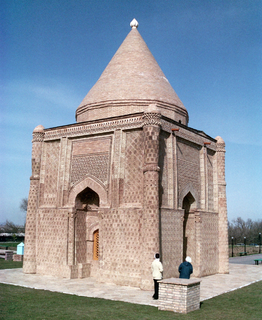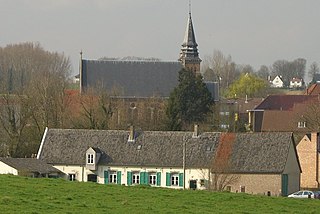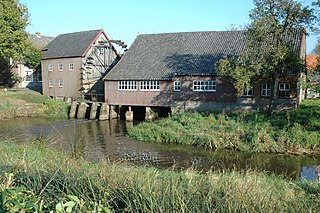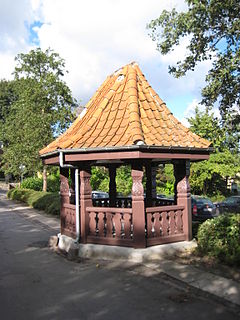

The watermill at Sint-Gertrudis-Pede (Pedemolen) in the municipality of Dilbeek is the only working watermill in the Pajottenland, and is protected as a monument since 1975


The watermill at Sint-Gertrudis-Pede (Pedemolen) in the municipality of Dilbeek is the only working watermill in the Pajottenland, and is protected as a monument since 1975
The original mill, built in 1392 was one of the five mills in the Land of Gaasbeek. After being destroyed by a fire in 1763, the mill was restored. Also living quarters were added. Until 1963, they kept milling with water power, after that they used an electric engine. The mill was completely shut down in 1970. In 1990 restoration was begun, so nowadays it still can be used as a mill. [1]
Today the monument only is used as a tourist attraction, with volunteers milling two Sundays every month. Apart from the mill, there are several ponds and an orchard located on the domain. [2]
The first depictions of the mill date back to the 16th century, after Pieter Bruegel the Elder used the mill as a model for his paintings The Return of the Herd and The Magpie on the Gallows .

A watermill or water mill is a mill that uses hydropower. It is a structure that uses a water wheel or water turbine to drive a mechanical process such as milling (grinding), rolling, or hammering. Such processes are needed in the production of many material goods, including flour, lumber, paper, textiles, and many metal products. These watermills may comprise gristmills, sawmills, paper mills, textile mills, hammermills, trip hammering mills, rolling mills, wire drawing mills.

Dilbeek is a municipality in the province of Flemish Brabant, in Flanders, one of the three regions of Belgium. The municipality comprises the villages of Dilbeek proper, Groot-Bijgaarden, Itterbeek, Schepdaal, Sint-Martens-Bodegem, and Sint-Ulriks-Kapelle. Dilbeek is located just outside the Brussels-Capital Region, in the Pajottenland, hence the local name Poort van het Pajottenland. Even though Dilbeek is located in the Dutch language area of Belgium, there is a French-speaking minority represented by 4 members on the 33-seat local council. It is a mostly residential community with largely preserved rural areas and some industrial zones.

The Darent is a Kentish tributary of the River Thames and takes the waters of the River Cray as a tributary in the tidal portion of the Darent near Crayford, as illustrated by the adjacent photograph, snapped at high tide. 'Darenth' is frequently found in the spelling of the river's name in older books and maps, Bartholomew's "Canal's and River of England" being one example. Bartholomew's Gazetteer (1954) demonstrates that Darent means "clear water" and separately explains the other name. Considering the River Darent runs on a bed of chalk and its springs rise through chalk, this is not surprising. The original purity of the water was a major reason for the development of paper and pharmaceuticals in the area.

Zibad is a village in Zibad Rural District, Kakhk District, Gonabad County, Razavi Khorasan Province, Iran. At the 2006 census, its population was 4243, in 1701 families.

The Aisha-Bibi is an 11th or 12th-century mausoleum for a noble woman located in the village of Aisha Bibi, 18 km (11 mi) west of Taraz, Kazakhstan on the Silk Road. It is locally famous as a monument to love and faithfulness.

Mapledurham Watermill is a historic watermill in the civil parish of Mapledurham in the English county of Oxfordshire. It is driven by the head of water created by Mapledurham Lock and Weir, on the River Thames. The mill was built in the 15th century, and further extended in the 17th, 18th and 19th centuries. It is a grade II* listed building and is preserved in an operational state.

A rijksmonument is a national heritage site of the Netherlands, listed by the agency Rijksdienst voor het Cultureel Erfgoed (RCE) acting for the Dutch Ministry of Education, Culture and Science.

The River Bourne rises in the parish of Ightham, Kent and flows in a generally south easterly direction through the parishes of Borough Green, Platt, Plaxtol, West Peckham, Hadlow, and East Peckham where it joins the River Medway. In the 18th century the river was known as the Busty or Buster, the Shode or Sheet, but is not known by these names nowadays. A bourne is a type of stream, while shode means a branch of a river.

The Loose Stream sometimes called the River Loose or Langley Stream is a tributary of the River Medway notable for the number of watermills that it powered in its short length. It rises in Langley, flows through Boughton Monchelsea, Loose and enters the Medway at Tovil. The river valley is deep sided, and there is much evidence of the paper and wool trades which once flourished here: the stream has been dammed in many places, resulting in many mill ponds.

The River Teise is a tributary of the River Medway in Kent, England. It begins in Dunorlan Park in Tunbridge Wells. and flows eastwards past Bayham Abbey and then through Lamberhurst. 2 miles downstream of Lamberhurst the small River Bewl, on which is the reservoir Bewl Water, joins the Teise.
The Medway and its tributaries and sub-tributaries have been used for over 1,150 years as a source of power. There are over two hundred sites where the use of water power is known. These uses included corn milling, fulling, paper making, iron smelting, pumping water, making gunpowder, vegetable oil extraction, and electricity generation. Today, there is just one watermill working for trade. Those that remain have mostly been converted. Such conversions include a garage, dwellings, restaurants, museums and a wedding venue. Some watermills are mere derelict shells, lower walls or lesser remains. Of the majority, there is nothing to be seen.

The River Stour has been used for centuries as a source of power. Many different processes were performed by the use of water power:- Corn milling, fulling, paper making and electricity generation. Many of the mills survive today as house conversions, with two of them still working commercially.
The Medway and its tributaries and sub-tributaries have been used for over 1,150 years as a source of power. There are over two hundred sites where the use of water power is known. These uses included corn milling, fulling, paper making, iron smelting, pumping water, making gunpowder, vegetable oil extraction, and electricity generation. Today, there is just one watermill working for trade. Those that remain have mostly been converted. Such conversions include a garage, dwellings, restaurants, museums and a wedding venue. Some watermills are mere derelict shells, lower walls or lesser remains. Of the majority, there is nothing to be seen. A large number of tributaries feed into the River Medway. The tributaries that powered watermills will be described in the order that they feed in. The mills are described in order from source to mouth. Left bank and right bank are referred to as though the reader is facing downstream. This article covers the watermills on the tributaries that feed in below Penshurst and above Yalding.

The city of Canterbury in Kent, England has been well served by mills over the centuries. These include animal engines, watermills and windmills.

Groot-Bijgaarden is a village and deelgemeente in the municipality of Dilbeek, a suburb of Brussels, in Flanders, Belgium.
Schepdaal is a village and deelgemeente of Dilbeek.

Sint-Gertrudis-Pede is a village in Dilbeek

The de Viron Castle is a castle in Dilbeek, which houses the offices of the local authority.

The Watermill at Opwetten is a watermill along the river Kleine Dommel, located on the Opwettenseweg 203 in Opwetten, Nuenen, Gerwen en Nederwetten, in the province of North Brabant, Netherlands. First mentioned in the 11th century, the watermill burned down and was rebuilt in 1764.

Maglekilde is the most powerful of several natural springs in Roskilde, Denmark. It formerly issued water at a rate of some 90,000 litres per hour but has now dropped to 15,000 litres per hour. A wellhouse was built over the spring in 1927. It is now listed.
| Wikimedia Commons has media related to Watermolen Sint-Gertrudis-Pede . |
|title= (help)